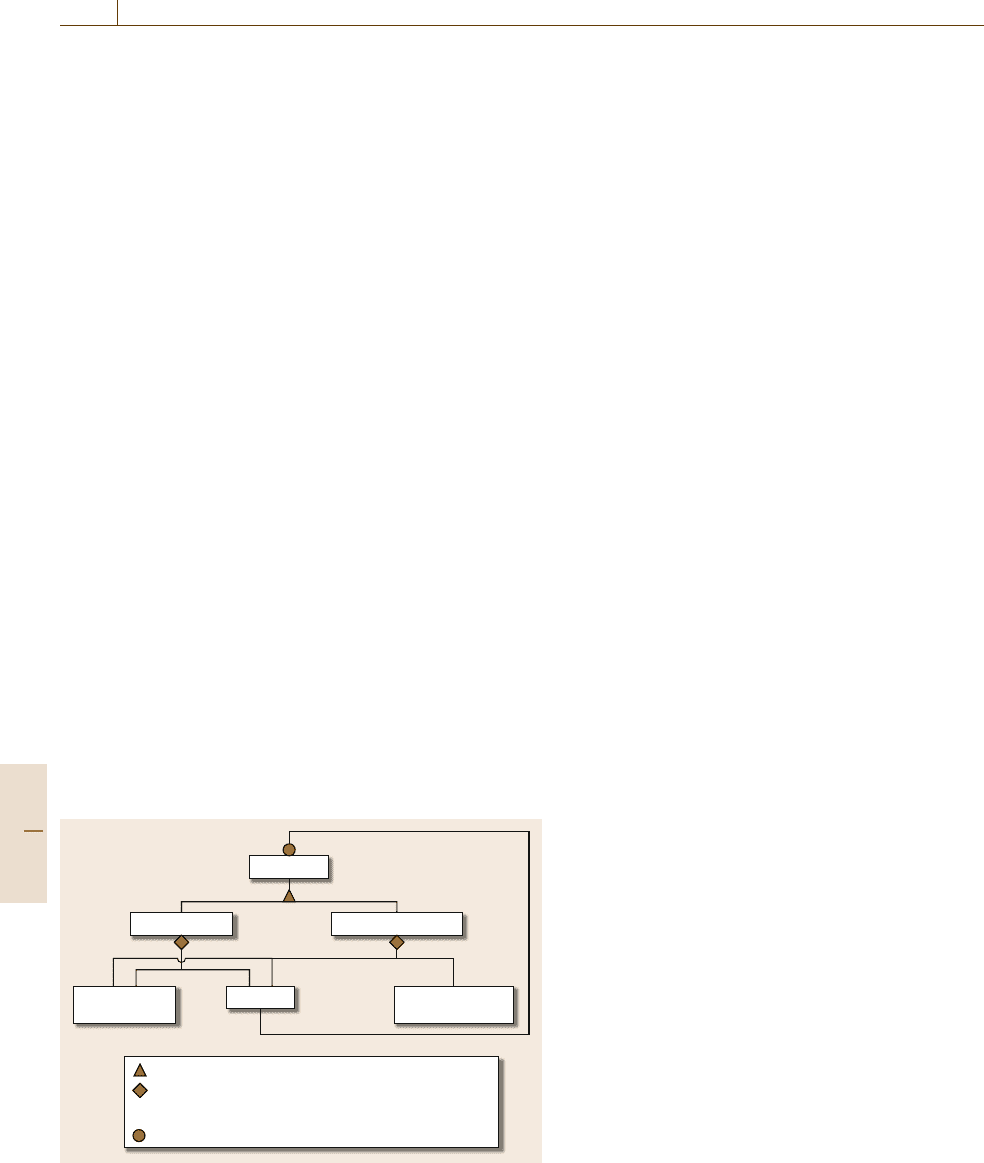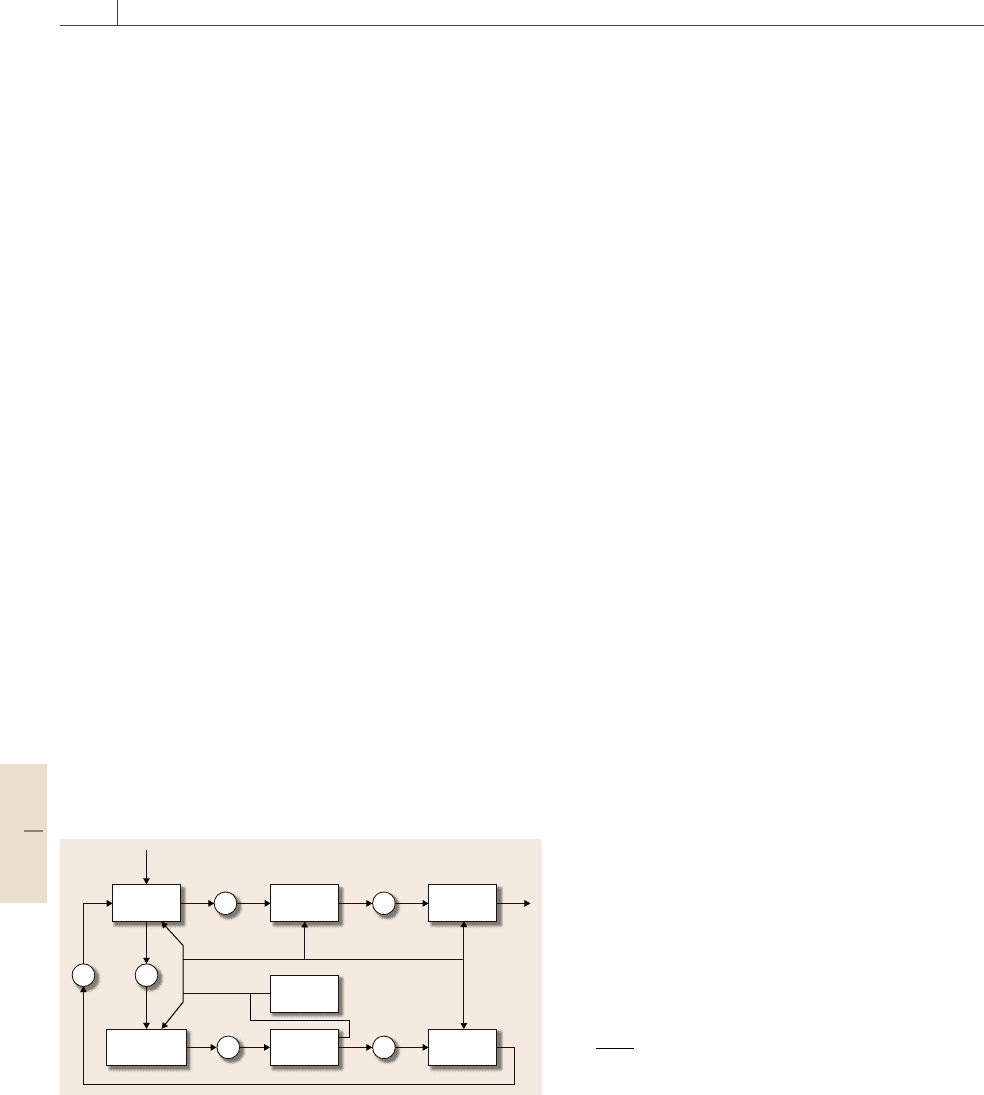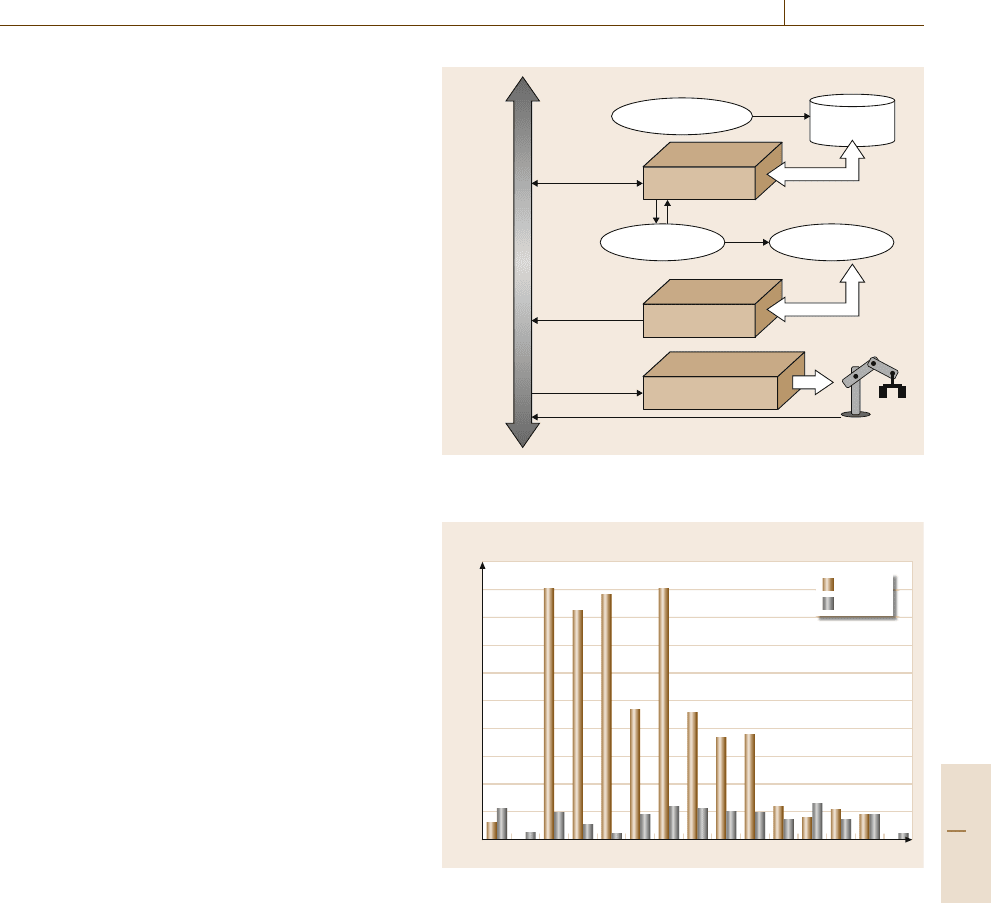Nof S.Y. Springer Handbook of Automation
Подождите немного. Документ загружается.


Large-Scale Complex Systems 36.2 Methods and Applications 625
be identified; for example, let (P1)bedefinedas
(P1) : extr[J
1
(v
1
)+J
2
(v
2
)];v
1
∈ V
1
;v
2
∈ V
2
,
(36.6)
then, twoindependent subproblems (P2
1
)and(P2
2
) can
be obtained
(P2
1
) : extr[J
1
(v
1
)]; v
1
∈ V
1
, (36.7)
(P2
2
) : extr[J
2
(v
2
)]; v
2
∈ V
2
. (36.8)
This decomposition is utilized in assigning separate
subproblems to the controllers which are situated at
the same level of a hierarchical pyramid or in de-
centralized control schemes where the controllers act
independently.
The parametric decomposition divides the large-
scale problem into a pair of subproblems by setting
temporary values toa set of couplingparameters.While
in one problem of the pair the coupling parameters are
fixed and all other variables are free, in the second sub-
problem they are free and the remaining variables are
fixed as solutions of the first subproblem. The two sub-
problems are solved through an iterative scheme which
starts with a set of guessed values of the coupling pa-
rameters; for example, let the large-scale problem be
defined as follows
(P1) : extr
v
[J(v)];v = (α, β) ;(α ∈ A) , (β ∈ B) ;
αRβ,
where α and β are the components of v, A and B are
two admissible sets, β is the coupling parameter, and R
is a relation between α and β. The problem (P1) can be
divided into the pair of subproblems (P2)and(P3)
(P2) : extr
α
J
α,
∗
β
; (α ∈ A) , (αRβ) ,
(P3) : extr
β
J
∗
α
(β),β
; (β ∈ B) ,
.
∃
∗
α
∗
α
∈ A
,
∗
α
Rβ
/
,
where
∗
α
(β) is the solution of (P2) for the given value
β=
∗
β
and
∗
β
is the solution of (P3)forthegivenvalue
α=
∗
α
.
The parametric decomposition is utilized to divide
the effort between a coordinating unit and the subset
of coordinated units situated at lower organization level
(echelon).
The structural decomposition divides the large-
scale problem into a pair of subproblems through
modifying the performance measure and/or con-
straints. While one subproblem consists in setting the
best/satisfactory formulation of the performance mea-
sure and/or admissible domain, the second one is to find
the solution of the modified problem. This manipulation
is utilized to divide the control effort between two levels
of control (layers).
From Coordination to Cooperation
The traditional multilevel systems proposed in the
1970s to be used for the management and con-
trol of large-scale systems can be viewed as pure
hierarchies [36.77]. They are characterized by the
circulation of feedback and intervention signals only
along the vertical axis, up and down, respec-
tively, in accordance with traditional concepts of
the command and control systems. They consti-
tuted a theoretical basis for various industrial dis-
tributed control systems which possess at highest
level a powerful minicomputer. Also the multilayer
and multiechelon hierarchies served in the 1980s
as a conceptual reference model for the efforts to
design computer-integrated manufacturing (CIM)sys-
tems [36.78,79].
Several new schemes have been proposed over the
last 25years to overcome the drawbacks and limits of
the practical management and control systems designed
in accordance with the concepts of pure hierarchies
such as: inflexibility, difficult maintenance, and lim-
ited robustness to major disturbances. The more recent
solutions exhibit ever more increased communication
and cooperation capabilities of the management and
control units. This trend has been supported by the
advancesin communicationtechnology andartificial in-
telligence; for example, even in 1977, Binder [36.80]
introduced the concept of decentralized coordinated
control with cooperation, which allowed limited com-
munication among the control unit placed at the same
level. Several years later, Hatvany [36.81] proposed the
heterarchical organization, which allows for exchange
of information among the units placed at various levels
of the hierarchy.
The term holon was first proposed by Koestler in
1967 [36.82] with a view to describing a general orga-
nization scheme able to explain the evolution and life of
biological and social systems. A holon cooperates with
other holons to build up a larger structure (or to solve
a complex problem) and, at the same time, it works to-
ward attaining its own objectives and treats the various
situations it faces without waiting for any instructions
from the entities placed at higher levels. A holarchy is
Part D 36.2

626 Part D Automation Design: Theory and Methods for Integration
a hierarchy made up of holons. It is characterized by
several features as follows [36.83]:
•
It has a tendency to continuously grow up by attract-
ing new holons.
•
The structure of the holarchy may permanently
change.
•
There are various patterns of interactions among
holons such as: communication messages, negotia-
tions, and even aggressions.
•
A holon may belong to more than one holarchy if it
observes their operation rules.
•
Some holarchies may work as pure hierarchies and
others may behave as heterarchical organizations.
Figure 36.4 shows an object-oriented representation of
a holarchy. The rectangles represent various classes of
objects such as pure hierarchies, heterarchical systems,
channels, and holons. This shows that the class of ho-
larchies may have particular subclasses such as pure
hierarchies and heterarchical systems. Also a holarchy
is composed of several constituents (subclasses) such
as: holons (at least one coordinator unit and two infi-
mal/coordinated units in the care of pure hierarchies)
and channels for coordination (in the case of pure hier-
archies) or channels for cooperation (in the case of pure
heterarchies). Coordination channels link the supremal
unit to, at least, two infimal units. While there are, at
least, two such coordination links in the case of pure
hierarchies, a heterarchical system may have no such
link. While, at least, one cooperation channel is present
in a heterarchical system, no such a link is allowed in
a pure hierarchy.
0+ 2+ 2+ 1+3+
n+
higher class has as particular forms…
higher class is made up of…
there may be n or more objects related to the class…
there may be none, one or more objects related to the class…
Holarchy
Heterarchical systemPure hierarchy
Horizontal channel
for cooperation
Vertical channel
for coordination
Holon
Fig. 36.4 Holarchies: an object-oriented description
Management and control structures based on
holarchy concepts were proposed by Van Brussel
et al. [36.84], Valckenaers et al. [36.85] for implemen-
tation in complex discrete-part manufacturing systems.
To increase the autonomy of the decision and
control units and their cooperation the multiagent tech-
nology is recommended by Parunak [36.57]andHadeli
et al. [36.53]. An intelligent software agent encapsu-
lates its code and data, is able to act in a proactive
way, and cooperates with other agents to achieve a com-
mon goal [36.86]. The control structures which utilize
the agent technology have the advantage of simplify-
ing industrial transfer by incorporating existing legacy
systems, which can be encapsulated in specific agents.
Ma
ˇ
r
´
ıkand La
ˇ
zansk
´
y [36.55]make a survey of industrial
applications of agent technologies which also considers
pros andcons ofagent-based systems.They also present
two applications:
a) A shipboard automation system which provides
flexible and distributed control of a ship’s equip-
ment
b) A production planning and scheduling system
which is designed for a factory with the possi-
bility of influencing the developed schedules by
customers and suppliers.
36.2.2 Other Methods and Applications
Decentralized Control
Feedback control of large-scale systems poses the stan-
dard control problem: to find a controller for a given
system with control input and control output ensur-
ing closed-loop systems stability and reach a suitable
input–output behavior. The fundamental difference be-
tween small and large systems is usually described by
a pragmatic view: a system is large if it is conceptually
or computationally attractive to decompose it into inter-
connected subsystems.Such subsystems are typically of
small size and canbe solved easier than theoriginal sys-
tem. The subsystem solutions can be combined in some
manner to obtain a satisfactory solution for the overall
system [36.87].
Decentralized control has consistently been a con-
trol of choice for large-scale systems. The prominent
reason for adopting this approach is its capability to
solve effectively the particular problems of dimen-
sionality, uncertainty, information structure constraints,
and time delays. It also attenuates the problems that
communication lines may cause. While in the hierar-
chical control schemes, as shown above, the control
Part D 36.2

Large-Scale Complex Systems 36.2 Methods and Applications 627
units are coordinated through intervention signals and
may be allowed to exchange cooperation messages,
in decentralized control, the units are completely in-
dependent or at least almost independent. This means
that the information flow network among the control
units can be divided into completely independent par-
titions. The units that belong to different subnetworks
are completely separate from each other. Only restricted
communication at certain time moments or intervals or
limited to small part of information among the units
is allowed. Decentralized structures are often used but
their performance is worse compared with the central-
ized case. The basic decentralized control schemes are
as follows:
•
Multichannel system. The global system is con-
sidered as one whole. The control inputs and the
control outputsoperate only locally. Thismeans that
each channel has available only local information
about the system and influences only a local part of
the system.
•
Interconnected systems. The overall system is de-
composed according to a selected criterion. Then
local controllers are designed for each subsystems.
Finally, the local closed-loop subsystems and inter-
connections are tested to satisfy the desired overall
system requirements.
At present a serious problem is the lack of rele-
vant theoretic and methodological tools to support
the scalable solution of new networked complex
large-scale problems including asynchronous issues.
The recent accomplishments are aimed at broaden-
ing the scope of decentralized control design methods
using linear matrix inequalities (LMIs) [36.31], dy-
namic interaction coordinator design to ensure the
desired level of interconnections [36.32], advanced de-
centralized control strategies for complex switching
systems [36.26], hybrid large-scale systems [36.27],
Petri nets [36.25], large-scale supply chain decentral-
ized coordination [36.28, 29], and distributed control
systems with network communication [36.30].
Simulation-Based Scheduling
and Control in LSS
In continuous, large-scale industrial plants such as in
chemical, power, and paper industries and waste-water
treatment plants, simulation-based scheduling starts
from creating scenarios for production and comparing
these scenarios for optimality and availability. Prob-
lems can vary from order allocation between multiple
production lines to optimal storage usage and detec-
tion and compensating for bottlenecks. Heuristic rules
are usually connected to simulation, making it possi-
ble to adjust the production to varying customer needs,
minimize the use of raw materials and energy, decrease
the environmental load, stabilize or improve the quality,
etc. Early applications in the paper industry are given
by Leiviskä et al. [36.38, 39]. The main problem is to
balance the production and several intermediate stor-
ages in (multiple) production lines, and give room for
maintenance shutdowns and coordinate production rate
changes. The model is based on the state model with
storage capacities as the state variables and production
rates as the control variables. Heuristics and bottleneck
considerations are connected to these systems. A newer,
agent-based solution has also been proposed [36.52].
There are also several classical optimization-based so-
lutions for this problem [36.19,21–24].
Modern chemical batch processes are large scale,
complex, serial/parallel, multipurpose processes. They
are especially common in the food and fine chemi-
cals industries. They resemble flexible manufacturing
systems common in electronics production. From the
scheduling and control point of view complexity brings
along also difficult interactions and uncertainty that are
difficult to tackle with conventional tools. Simulation-
based scheduling can include as much complexity as
needed, and it is a largely used tool in the eval-
uation of the performance of different optimizing
systems. Connecting heuristics or rule-based systems
to simulation makes it also a flexible tool for batch
process scheduling. Modeling approaches differ, e.g.,
real-time simulation using Petri nets [36.36]andthe
combination of discrete event simulation with genetic
algorithms for the steel annealing shop have been pro-
posed [36.40].
Flexible manufacturing systems, e.g., for compo-
nents assembly, offer several difficulties for production
scheduling and control. Dynamic, random nature is one
main concern in operation control. Also quickly chang-
ing products and production environments, especially
in electronics production, lead to a great variability
in requirements for production control. In real cases,
it is also typical that several scenarios must be cre-
ated and evaluated. The handling of uncertain and
vague information itself causes also problems in real-
world applications. Uncertain data has to be extracted
from data sources avoiding noise, or at least avoiding
increasing it.
Discrete event simulation models the system as it
propagates overtime, describing thechanges asseparate
Part D 36.2

628 Part D Automation Design: Theory and Methods for Integration
discrete events. This approach also found a lot of appli-
cations in manufacturing industries, queuing systems,
and so on. An early application to jobshop schedul-
ing is presented by Filip et al. [36.20], who utilize
variouscombinations ofseveral dispatchingrules tocre-
ate the list of future events. Taylor [36.17] reported
on an application of discrete event simulation, com-
bined with heuristics, to the scheduling of the printed
circuit board(PCB) assemblyline. Thesituation is com-
plicated by the fact that the production control must
operate on three levels: at the system level concerning
production mix problems, at the cell level for routing
problems, and at the machine level to solve sequenc-
ing problems. Discrete event simulation is also the key
element in the shop floor scheduling system proposed
by Gupta et al. [36.35]. The procedure starts by creat-
ing feasible schedules for the telephone terminals plant,
helps in taking other requirements into account and in
tackling uncertainties, andmakes reschedulingpossible.
A system integrating simulation and neural networks
has been used in photolithography toolset schedul-
ing in wafer production [36.33]. The system uses the
weighted-score approach, and the role of the neural net-
work is to update the weights set to different selection
criteria. Fuzzy logic provides the arsenal of methods for
dealing with uncertainties. Several examples for PCB
production are given by Leiviskä [36.45].
Two-stageapproaches havebeen usedin bottleneck-
based approaches [36.34]. The first-pass simulation
recognizes the bottlenecks, and their operation are opti-
mized during the second-pass simulation. Better control
of work in bottlenecks improves the performance of the
whole system. The main dispatching rule is to group to-
gether the lots that need the same setups. The system
also reveals the non-bottleneck machines and makes it
possible to apply different dispatching rules according
to the process state. The example is from semiconductor
production.
In practice, scheduling is a part of the decision
hierarchy starting from the enterprise-level strategic de-
cisions and going down to machine-level order or tools
scheduling. Simulation is used at different levels of this
hierarchy to provide interactive means for guarantee-
ing the overall optimality or at least the feasibility of
the decisions made at different levels. Such integrated
and interactive approaches exist also in supply-chain
management systems. In large-scale manufacturingsys-
tems, supply-chain control must take four interacting
factors into account: suppliers, manufacturing, distri-
bution, network, and customers. To control all these
interactions successfully, various operating factors and
constraints – processing times, production capacities,
availability of raw materials,inventory levels, and trans-
portation times – must be considered.
Discrete event simulation is also one possibility
to create an object-oriented, scalable, simulation-based
control architecture for supply-chain control [36.41].
Requirements for modularity and maintainability also
lead to distributed simulation models, especially when
a simulation-based control architecture is controlling
supply chain interactions. This means a modeling tech-
nique including a federation of simulation models that
are solved in a coordinated manner. The system archi-
tecture is presented in [36.42]. Each supply-chain entity
has two simulation models associated with it – one
running in real time and the other as a lookahead sim-
ulation. The lookahead model is capable of predicting
the impact of a disturbance observed by the real-time
model. A federation object coordinator (FOC) coor-
dinates the real-time simulation models. In this case,
a master event calendar allocates interprocess events
to all simulation models and resynchronizes all simu-
lations at the end of every activity [36.37].
In simulation-basedcontrol the controller makes de-
cisions based both on the current state of the system and
future scenarios, usually produced by simulation. Here,
the techniques for calculation of these scenarios play
the main role. Ramakrishnan and Thakur [36.42]pro-
posed the extension sequential dynamic systems (SDS)
that they call input–output SDS to model and analyze
distributed control systems and to compensate for the
weaknesses of automata-based models. They use the
discrete-part production plant as an example.
Artificial Intelligence-Based Control in LSS
Artificial intelligence (AI)-based control in large-scale
systems uses, in practice, all the usual methods of intel-
ligent control: fuzzy logic, neural networks, and genetic
algorithms together with different kinds of hybrid solu-
tions [36.88]. Thecomplex nature ofapplications makes
the use of intelligent systems advantageous. Dealing
with thiscomplexity is alsothe biggest challenge for the
methodological development: the large-scale process
structures, complicated interconnections, nonlinearity,
and multiple time scales make the systems difficult
to model and control. Fuzzy logic control (FLC)has
found most of its applications in cases which are dif-
ficult to model, suffer from uncertainty or imprecision,
and where a skilful operator is superior to conven-
tional automation systems. Artificial neural networks
(ANN) contribute to modeling and forecasting tasks
and combined with fuzzy logic in neuro-fuzzy systems
Part D 36.2

Large-Scale Complex Systems 36.2 Methods and Applications 629
combine the benefits of both approaches. Genetic algo-
rithms (GA), which are basically optimization systems,
are used in tuning models and controllers. See Chap.14
on Artificial Intelligence and Automation for additional
content.
As shown above, the control of large-scale industrial
plants have usually been based on distributed hardware
and hierarchical design of control functions [36.89,90].
The supervisoryand local control levels lay under enter-
prise and mill-wide control levels. Supervisory control
provides the local controls with the set points that ful-
fil the quality and schedule requirements coming from
the mill-wide level and help in optimizing the operation
of the whole plant. This optimization leaves room for
versatile application of intelligent methods. Local units
on the other hand, control the actual process variables
according to the set points given by the supervisory
control level. Even though the proportional–integral–
differential (PID) controller is by far the most important
tool, intelligent control plays an increasing role also
at the local control level. Intelligent methods have
been useful in tuning local PID controllers. In practice,
fuzzy controllers must have adaptive capabilities. Gain
scheduling isa typical approach for large-scale systems,
butapplications ofmodel referenceadaptive controland
self-tuning adaptive control exist. Self-tuning has been
used in controlling a pilot-scale rotary drum where the
disturbances are due to long and varying time delays
and changes in the raw materials [36.46].
Model-based control techniques, e.g., model predic-
tive control (MPC), have been applied for the control of
processes with a long delay or dead time. In MPC,the
controller based on a plant model determines a manipu-
lated variable profile that optimizes some performance
objectives over the time in question. ANN are used
in replacing the mathematical models in optimization
as shown in a survey made by Hussain [36.48]. Also
Takagi–Sugeno fuzzy models are used in connection
with model-based predictive control [36.44]. Hybrid
systems include both continuous- and/or discrete-time
dynamics together with discrete events. So their state
consists of real-valued, discrete-valued, and/or logical
variables. Support vector machines have been used as
a part of MPC strategy for hybrid systems [36.91].
Power systems have been an important applica-
tion field for intelligent control since 1990s [36.92].
Design of centralized controllers is difficult for many
obvious reasons: power systems are large scale and de-
centralized by nature. They are also nonlinear and have
multiple dynamics and considerable time delays. De-
centralized local control can apply linear models and
purely local measurements. Available transfer capabil-
ity (AT C) is a real-time index used in monitoring and
controlling the power transactions and avoiding over-
loading of the transmission lines [36.47]. There are
difficulties in calculating it accurately online for large-
scale systems. Decreasing the number of input variables
to only three and using fuzzy modeling helps in this.
Simulations show that neural-networks-based local ex-
citation controls can take care of interactions between
generators and dampen oscillations effectively. Neural
networks are used in approximating unknown dynamics
and interconnections [36.40]. The designing of the con-
troller for two-area hydrothermal power systems based
on genetic algorithm improves the rise time and settling
time, and simulations show that the proposed technique
is superior to the traditional methods [36.51]. A local
Kalman filter and genetic algorithms estimate all local
states and interactions between subsystems in a large-
scale power system. The controller uses theseestimates,
optimizes a given performance index,and thenregulates
the system states [36.50].
Agent-based technologies have been used in com-
plex, distributed systems. Good examples come from
intelligent control of highly distributed systems in the
chemical industry and in the area of utility distribu-
tion (power, gas, and waste-water treatment). As shown
above, holonic agents take care of machine or cell-level
(local) controls, sometimes even integrated with ma-
chines. Intelligent agents can be associated with each
manufacturing unit and they communicate, coordinate
their activities, and cooperate with each other.
Fault detection and diagnosis (FDD) may be tack-
led by decomposing the large-scale problem into
smaller subtasks and performing control and FDD lo-
cally [36.93]. Large-scale complex power systems need
systematic tools for protection and control. The su-
pervisory control technique and a design procedure
of a supervisor that coordinates the behavior of relay
agents to isolate fault areas are presented in [36.56].
Multiagent systems have also been used in identifica-
tion and control of a 600MW boiler–turbine–generator
unit [36.54]. In this case, online identifiers are used
for control and offline identifiers for fault diagnosis.
Event-based approaches are used for building large-
scale distributed systems and applications, especially
in a networked environment. A hybrid approach of
event-based communications for real-time manufac-
turing supervisory control is applied for large-scale
warehouse management [36.94]. See Chap.30 on Au-
tomating Error and ConflictPrognosticsand Prevention
for additional content.
Part D 36.2

630 Part D Automation Design: Theory and Methods for Integration
Computer-Supported Decision Making
in Large-Scale Complex Systems
As shown above, a possible solution to many LSS
control problems is the use of artificial-intelligence
methods. However, in the field, due to strange combi-
nations of external influences and circumstances, rare
or new situations may show up that were not taken into
consideration at design time. Already in 1990, Martin
et al. remarked that [36.95]:
although AI and expert systems were successful in
solving problems that resisted to classical numeri-
cal methods, their role remains confined to support
functions, whereas the belief that evaluation by man
of the computerized solutions may become superflu-
ous is a very dangerous error.
Based on this observation, Martin et al. [36.95] rec-
ommended appropriate automation, which integrates
technical, human, organizational, economical, and cul-
tural factors.
The decision support system concept (DSS)ap-
peared in the early 1970s. As with any new term, the
significance of DSS was in the beginning rather vague
and controversial.While some peopleviewedit asa new
redundant term used to describe a subset of manage-
ment information systems (MIS), some other argued it
was a new label abusively used by some vendors to take
advantage of a new fashion. Since then many research
and development activities and applications have wit-
nessed that the DSS concept definitely meets a real need
and there is a market for it even in the context of real-
time applications in the industrial milieu [36.96,97].
The Nobel Prize winner H. Simon [36.98] identi-
fied three steps of the decision-making (DM) process,
namely:
a) Intelligence,consisting ofactivitiessuch as data col-
lection and analysis in order to recognize a decision
problem
b) Design, includingactivities such as model statement
and identification/production and evaluation of var-
ious potential solutions to the problem
c) Choice, or selection of a feasible alternative for im-
plementation.
Later, he added a fourth step – implementation and
result evaluation – which may correspond to supervi-
sory control in industrial milieu. If a decision problem
cannot be entirely clarified and all possible decision al-
ternatives cannot be fully explored and evaluated before
a choice is made, then the problem is said to be unstruc-
tured or semistructured. If the problem were completely
structured, an automatic device could have solved the
problem without any human intervention. On the other
hand, if the problem has no structure at all, nothing
but hazard can help. If the problem is semistructured
a computer-aided decision can be envisaged.
Most of the developments in the DSS domain have
initially addressed business applications not involving
any real-time control. However, even in the early 1980s
DSS were reported to be used in manufacturing con-
trol [36.20, 99]. In 1987, Bosman [36.100] stated that
control problems could be looked upon as a natural
extensionand as a distinct element of planning decision-
making processes (DMP). Almost 20years later, Nof
et al. state [36.12]:
...
the development and application of intelligent
decision support systems can help enterprises cope
with problems of uncertainty and complexity, to in-
crease efficiency, join competitively in production
networks, andimprove the scopeand quality of their
customer relations management (CRM).
Real-time decision-making processes (RT DMPs)
for controlapplications are characterizedby severalpar-
ticular aspects such as:
a) They involve continuous monitoring of a dynamic
environment.
b) They are short time horizon oriented and are carried
out on a repetitive basis.
c) They normally occur under time pressure.
d) Long-term effects are difficult to predict [36.101].
It is quite unlikely that an econological (eco-
nomically logic) approach, involving optimization, be
technically possible for genuine RT DMPs. Satisficing
approaches, which reduce the search space at the ex-
pense of the decision quality, or fully automated DM
systems, if taken separately, cannot be accepted either,
but for some exceptions. At the same time, one can
notice that genuine RT DMP can show up in crisis sit-
uations only; for example, if a process unit must be
shut down due to an unexpected event, the production
schedule of the entire plant might become obsolete. The
right decision will be to take the most appropriate com-
pensation measures to manage the crisis over the time
period needed to recomputed a new schedule or up-
date the current one. In this case, a satisficing decision
may be appropriate. If the crisis situation has been met
previously and successfully surpassed, an almost auto-
mated solution based on past decisions stored in the
Part D 36.2

Large-Scale Complex Systems 36.2 Methods and Applications 631
Table 36.2 Possible task assignment in DSS
Decision steps andactivities EU NU NM ES ANN CBR IA
Intelligence
• Setting objectives I M I/M P/M
• Perception of DM situation IM P M/I
• Problem recognition IM P M/I
Design
• Model selection EM I I
• Model building M P I/M P
• Model validation IM
• Setting alternatives PMP
Choice
• Model experimenting M/I
– Model solving EE I
– Result interpreting I PP
– Parameter changing EM/I
• Solution adotiing E
• Sensitivity analysis MI
Release for implementation EE P
EU – expert user, NU – novice user, NM – numerical model, ES – rule-based expert system, ANN – artificial
neural network, CBR – case-based reasoning, GA – genetic algorithm, IA – intelligent agent, P – possible, M –
moderate, I – intensive, E – essential
information system can be accepted and validated by
the human operator. On the other hand, the minimiza-
tion of the probability of occurrences of crisis situations
should be considered as one of the inputs (expressed as
a set of constraints or/and objectives) in the scheduling
problem [36.96,102].
In many problems, decisions are made by a group of
persons instead of an individual. Because the group de-
cision is either a combination of individual decisions or
a result of the selection of one individual decision, this
may not be rational in Simon’s acceptance. The group
decision is not necessarily the best choice or a combi-
nation of individual decisions, even though those might
be optimal, because various individuals might have
various perspectives, goals, information bases, and cri-
teria of choice. Therefore, group decisions show a high
social nature, including possible conflicts of interest,
different visions, influences, and relations [36.103].
Consequently, a group (or multiparticipant) DSS needs
an important communication facility.
The generic framework of a DSS, proposed by
Bonczek et al. in 1980 [36.104] and refined later by
Holsapple and Whinston [36.105] is quite general and
can accommodate the most recent technologies and
architectural solutions. It is based on three essential
components. The first one is the language (and com-
munications) subsystem (LS).Thisisusedfor:
a) Directing data retrieval, allowing the user to invoke
one out of a number of report generators
b) Directing numerical or symbolic computation, en-
abling the user either to invoke the models by names
or construct model and perform some computation
at his/her free will
c) Maintaining knowledge and information in the sys-
tem
d) Allowing communication among people in case of
a group DM
e) Personalizing the user interface.
The knowledge subsystem (KS) normally contains:
a) Empirical knowledge about the state of the applica-
tion environment in which the DSS operates
Part D 36.2

632 Part D Automation Design: Theory and Methods for Integration
b) Modeling knowledge, including basic modeling
blocks and computerized simulation and optimiza-
tion algorithms to use for deriving new knowledge
from the existing knowledge
c) Derived knowledge containing the constructed mod-
els and the results of various computations
d) Meta-knowledge (knowledge about knowledge)
supporting model building and experimentation and
result evaluation
e) Linguistic knowledge allowing the adaptation of
system vocabulary to a specific application
f) Presentation knowledge to allow for the most appro-
priate information presentation to the user.
The third essential component of a DSS is the
problem processing subsystem (PPS), which enables
combinations of abilities and functions such as in-
formation acquisition, model formulation, analysis,
evaluation, etc.
It has been noticed that some DSS are oriented
towards the left hemisphere of the human brain and
some others are oriented towards the right hemisphere.
While in the first case quantitative and computational
aspects are important, in the second pattern recogni-
tion and reasoning based on analogy prevail. In this
context, there is a significant trend towards combin-
ing numerical models and models that emulate the
human reasoning to build advanced DSS [36.106].
A great number of optimization algorithms have been
developed and carefully tested so far. However, their ef-
fectiveness in decision making has been limited. Over
the last three decades traditional numerical methods
have, along with databases, been essential ingredientsof
DSS. Froman informationtechnology perspective,their
main advantages [36.107] are: compactness, computa-
tional efficiency (if the model is correctly formulated),
and the market availability of software products. On
the other hand, they present several disadvantages. Be-
cause they are the result of intellectual processes of
abstraction and idealization, they can be applied to
problems which possess a certain structure, which is
hardly the case in many real-life problems. In addi-
tion, the use of numerical models requires that the
user possesses certain skills to formulate and experi-
ment the model. As was shown in the previous section,
AI-based methods supporting decision making are al-
ready promising alternatives and possible complements
to numerical models. New terms such as tandem sys-
tems,orexpert DSS (XDSS) have been proposed for
systems that combine numerical models with AI-based
techniques. An ideal task assignment is given in Ta-
ble 36.2 [36.97].
36.3 Case Studies
The following case studies illustrate how combinations
of methods may be utilized to solve large-scale complex
problems.
Digester
s
2
s
1
s
4
s
3
s
6
s
5
m
1
w
1
m
4
m
5
m
2
m
3
Bleaching
Auxiliary
boiler
Recovery
boiler
Drying
machine
Caustici-
zation
Evaporation
Fig. 36.5 Pulp mill model
36.3.1 Case Study 1:
Pulp Mill Production Scheduling
Figure 36.5 shows the pulp mill modeled as a common
state-space system. The state of the system s(t)isde-
scribed by the amount of material in each storage tank.
The production rates of the processes are chosen as
control variables forming the control vector m(t). The
required pulp production is usually taken as a determin-
istic known disturbance vector w(t).
The operation of the plant presented in Fig.36.5 is
described by the vector–matrix differential equation
ds(t)
dt
=Bm(t)+Cw(t) ,
where B and C are coefficient matrices describing the
relationships between the model flows (transfer ratios).
Part D 36.3

Large-Scale Complex Systems 36.3 Case Studies 633
Since the most storage tanks have only one input flow
and one output flow, most elements in B and C matrices
equal zero.
If the steam balance (dashed line in Fig. 36.5)isin-
cluded in scheduling, an additional variable describing
the steam development in the auxiliary boiler is re-
quired. It is a scalar variable denoted by S. Accordingly,
the steam balance is
S(t) = Dm(t)+ Ew(t) .
Note that the right-hand side of the balance includes
both consumption and generation terms. The variables
in the model are constrained by the capacity limits of
tanks and processes in the following way
s
min
≤s(t) ≤s
max
,
m
min
≤m(t) ≤m
max
,
S
min
≤ S(t) ≤ S
max
.
Due to the fact that scheduling is concerned with
relatively long time intervals, no complete and com-
plicated process models are necessary. If all the small
storage tanks are included in the model, the system
dimensions increase and it becomes difficult to deal
with. These tanks also have no meaning from the con-
trol point of view. Simpler model follows by combining
small storage tanks.
There are several ways to solve the scheduling
problem as shown before. Optimization can benefit
from decomposition and solving of smaller problems
as described in Sect. 36.2.1. A review of methods is
presented in [36.39]. It seems, however, that no ap-
proach alone can deal with this problem successfully.
Hybrid systems, consisting of algorithmic, rule-based,
and intelligent parts integrated with each other, and
also agent-based systems, could be the best possible
answer [36.97,110].
36.3.2 Case Study 2: Decision Support
in Complex Disassembly Lines
In [36.108], the control of a complex industrial disas-
sembly process of out-of-use manufactured products is
studied. The disassembly processes are subject to uncer-
tainties. The most difficult problem in such systems is
that a disassembly operation can fail at any moment be-
cause of the product or component degradation. In this
case one has to choose between applying an alternative
disassembly destructive operation (dismantling), and
aborting the disassembly procedure. This decision must
be taken in real time because in a used product the com-
ponents states are not known from the beginning of the
Product
Model
Planner
Ethernet
network
DB + KB
Simulation
DSS
Direct control system
Fig. 36.6 DSS integration in the multilayer control system (af-
ter [36.108])
123456789101112131415
Delay
Median
Standard
100
90
80
70
60
50
40
30
20
10
0
Fig. 36.7 The results of time delay estimation for one group (af-
ter [36.109])
process. The solution is to integrate a decision support
system (DSS) in the architecture of a multilayer system.
AsshowninFig.36.6, the control and decision tasks are
distributed among three levels: planning, decision sup-
port, and direct control. The disassembly planner gives
the sequence of the components that must be separated
to achieve the target component. The planner fuses the
information from the artificial vision system with that
contained in the database for each component or sub-
assembly. Amodel of the product isgenerated. The DSS
integrates the model and performs the simulation to rec-
Part D 36.3

634 Part D Automation Design: Theory and Methods for Integration
ommend a good disassembly sequence with respect to
the economical criteria.
36.3.3 Case Study 3: Time Delay Estimation
in Large-Scale Complex Systems
In data-based modeling of large-scale complex systems,
the exact determination of time delays is extremely dif-
ficult. The methods for delay estimation are widely
studied in control engineering, but these studies are
mainly limited to the two-variable cases, i.e., estimating
the delay between the manipulated and the controlled
variable in the feedback control loop. The situation is
totally different when dealing with a large number of
variables grouped in several groups for modeling or
monitoring purposes.
Mäyrä et al. [36.109] discuss a delay estimation
scheme combining genetic algorithms and principal
component analysis (PCA). Delays are optimized with
genetic algorithms with objective functions based on
PCA. Typically, a genetic algorithm maximizes the
variance explained by the first or two first principal
components. The paper gives an example using simu-
lation data of the paper machine, which includes over
50 variables. The variables were first grouped based
on the cross-correlation and graphical analysis into five
groups, and delays were estimated both forthe variables
inside the groups and between the groups. The results
for one group of 15 variables are given in Fig. 36.7.
The estimation was repeated 60 times and the fig-
ure shows the median and standard variance of these
simulations.
36.4 Emerging Trends
Large-scale complex systems have become a research
and development domain of automation with a series
of rather established method and technologies and in-
dustrial application. Table 36.3 contains a summary of
references to basic concepts.
Table 36.3 Key to references on basic concepts
Basic books Mesarovic, Macko, Takahara [36.7]; Wismer [36.61]; Titli [36.17];
Ho and Mitter [36.62]; Sage [36.63];
ˇ
Siljak [36.3,64]; Singh [36.65];
Findeisen et al. [36.16]; Jamshidi [36.6]; Lunze [36.66];
Brdys and Tatjewski [36.18]
Hierarchies Mesarovic, Macko, Takahara [36.7]
Strata Sage [36.63]; Schoeffler [36.68]
Layers Findeisen [36.8]; Havlena and Lu [36.73]; Isermann [36.72];
Lefkowitz [36.111]; Schoeffler [36.68]; Brdys and Ulanicki [36.112]
Echelons Brosilow, Lasdon and Pearson [36.74]; Lasdon and Schoeffler [36.75]
Heterarchy Hatvany [36.81]
Holarchy Hop and Schaeffer [36.83]; Koestler [36.82]; Van Brussel et al. [36.84];
Valckenaers et al. [36.85]
Decision support systems Bonczek, Holsapple and Whinston [36.104]; Bosman [36.100];
Chaturverdi et al. [36.101]; De Michelis [36.103]; Dutta [36.107]; Filip [36.96];
Filip et al. [36.21]; Filip, Donciulescu and Filip [36.97];
Holsapple and Whinston [36.105]; Kusiak [36.106]; Martin et al. [36.95];
Nof [36.99]; Nof et al. [36.12]; Simon [36.98]
At present academics and industrialpractitioners are
working to adapt the methods and practical solutions in
the LSS field to modern information and communica-
tion technologies andnewenterprise paradigms.Several
significant trends which can be noticed or forecast are:
Part D 36.4
